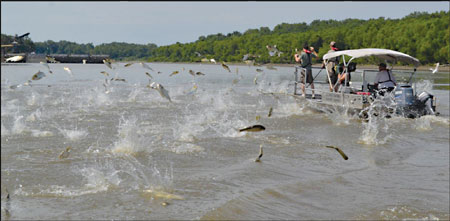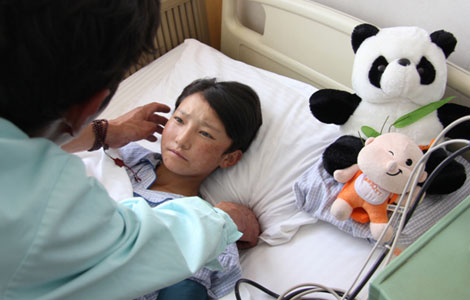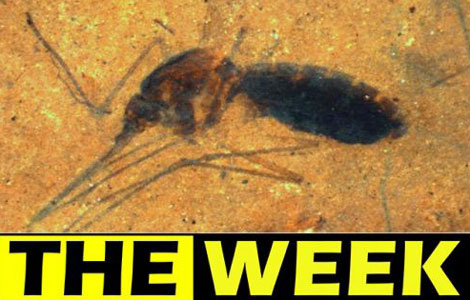The fish that didn't get away
Updated: 2013-10-18 13:03
By Caroline Berg (China Daily USA)
|
||||||||
|
A pool of silver carp show their leaping ability for a crew from the Asian Carp Regional Coordinating Committee, a subsidiary of the US Army Corps of Engineers. Kevin Irons / DNR |
No market
"Our commercial fishers at the beginning had a hard time because there was no market for bighead or silver carp," Irons said. "But we can really affect populations with our removal efforts."
In 2010, Illinois Governor Pat Quinn made a deal with a Beijing animal husbandry official to ship as much as 30 million pounds of Asian carp a year to China.
Irons said the Illinois Department of Commerce has supported the expansion of Big River Fish Corporation in Pearl, to install new flash freezers to increase their ability of moving fish in containers to China and elsewhere overseas.
Just across the border in Kentucky is Two Rivers Fisheries, which was established this year to purchase Asian carp from local fishermen to process and export.
Customers in China are placing orders, including one for 1 million pounds, for which Two Rivers shipped its first 40,000-pound load of carp in August, according to a report by WKMS 91.3 FM public radio. Owner Angie Yu told China Daily that Two Rivers' prices range between $0.10-0.45 per pound of carp, depending on the quality.
"Asian carp are kind of a disaster here [in the US], but it's a good food in China," Yu said. "We've got a lot of reports about the very good quality of our fish."
She said the 36,000-square-foot facility - the first and currently biggest Asian carp processing plant in the US - can process 6,000-20,000 pounds of Asian carp a day, depending on how much her 15 crews of fishermen manage to haul. She also said Two Rivers employs 26-30 people, and is looking to hire more.
Last month, an Illinois business development network held a "Carpe Carpio," - "seize the carp" - meeting to outline carp economic opportunities, which the group said could total $40 million a year through food products, carp pituitary extract and even carp collagen, according to a Chicago Tribune report.
For its part, Irons said Schafer Fisheries has partnered with the local DNR to collect Asian carp to convert into liquid fish fertilizer.
Still, the Illinois River teems with carp, and a lack of nearby processing plants, along with the brief time it takes for the fish to spoil, have complicated transportation for fishermen, according to the Tribune.
"Unfortunately, I don't see any kind of silver bullet to get rid of the problem totally," Irons said. "I think in the Illinois, Mississippi, Ohio Rivers, they're likely stuck with these guys for a long time."
In 2010, the Great Lakes Commission (GLC) and the Great Lakes and St. Lawrence Cities Initiative joined forces on a project to study the feasibility of restoring the natural divide separating the Great Lakes and Mississippi River Basins in the Chicago Area Waterway System (CAWS).
The CAWS includes an approximately 130-mile array of natural and constructed rivers, canals, locks and other structures in Chicago and northwest Indiana constructed beginning in the 1890s.
The system benefits the Chicago region, including conveying treated wastewater, supporting commercial shipping, managing flood water, and moving recreational and tour boats, according to an executive summary by the GLC.
The project's researchers have come up with three viable options to restore the divide. The least expensive option, which would build four barriers on CAWS branches between Lockport and Lake Michigan, would cost households in the Great Lakes region about $1 a month through 2059.
The savings
The group estimates between $1.4 billion to $9.5 billion would be garnered in long-term savings from evading aquatic invasive species control costs and damages alone. Benefits for the Chicago region and the Great Lakes and Mississippi River basins as a whole would also include improved water quality, strengthened flood protection, and modernized shipping facilities, according to the executive summary.
"Quite frankly, we're all in this together," said Terry Quinney, provincial manager of fish and wildlife services for Ontario Federation of Anglers and Hunters (OFAH). "Canadians, Americans, our joint societies, our joint economies - we all need to work together to ensure a healthy environment to continue to supply healthy economic opportunities."
Between 2009 and 2011, a group of scientists from the University of Notre Dame, the Nature Conservancy and Central Michigan University, collected more than 28,000 water samples from parts of the Great Lakes and tributaries, according to an Associated Press report published in April this year.
The report said laboratory analysis uncovered 58 positive DNA results for bighead or silver carp in the Chicago Area Waterway System (CAWS) - a network of rivers and canals linked directly to Lake Michigan - and six in western Lake Erie.
Sampling by the US Army Corps of Engineers and other federal agencies have also yielded positive results in Chicago waterways, but the question is the source of this DNA, according to the report.
Federal agencies said bird feces, fish sampling gear, barges and storm sewers could have transported the DNA. The opposing group of scientists argues that there are actually live Asian carp in these waters.
In Lake Erie, DNA was discovered 100 miles from waterways infested with Asian carp, the AP story reported. Therefore, the research group said if birds were the source, it would mean birds feasted on carp, flew 100 miles and excreted feces within a few hours of when the researchers collected water samples. Although possible, the researchers said they find it highly unlikely.
"Scientists are still finding DNA on this side of the border in the Great Lakes, and that's concerning," Nancy Goucher, water programs manager at the Toronto-based Environmental Defence, told China Daily. "We're not sure what the source of that DNA is, but what it means to me is we need to be looking at all the potential pathways of introduction."
In May, the Illinois state government launched a campaign called "Be a Hero - Transport Zero," to raise awareness about how the public can help prevent the spread of invasive species in waterways.
"Asian carp has kind of been the poster child for raising public awareness about invasive species," Irons said. "We really need people to think about these things."
In Ontario, the provincial government has teamed up with OFAH to build more public awareness.
Most Viewed
Editor's Picks

|

|

|

|

|

|
Today's Top News
China has to brace for next dollar drama
Life of Pi artwork on display
No criminal charges in Asiana crash death: DA
US deal key to nabbing fugitives
Seattle high-tech summit talks 'green'
JPMorgan reaches $13b deal
China is reaching its tipping point
Beijing works to spur global development
US Weekly

|

|

















